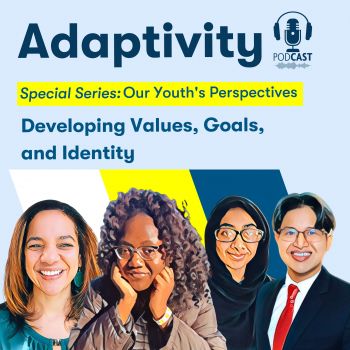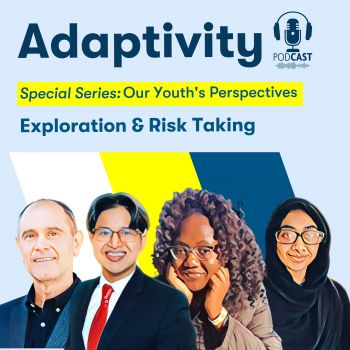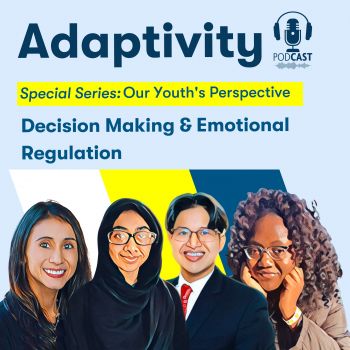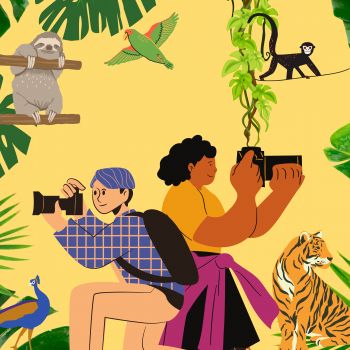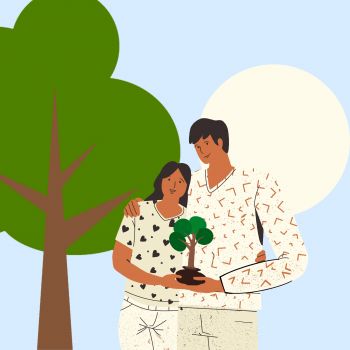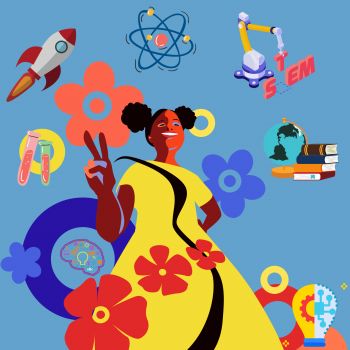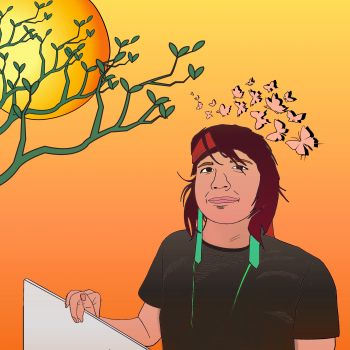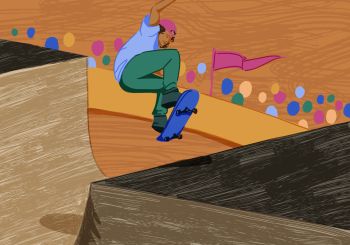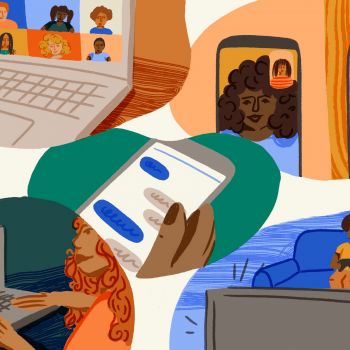Ron Dahl Our adolescent years are a period of remarkable growth and formative learning—a time when our learning experiences are interacting with maturational changes at the level of neural systems and our genetic predispositions. Together these can have a profound impact on our development.
Emily Zhu Obviously we both came from the same parents and we share a lot of our genetic makeup in that sense. And at the same time, we’re such different people with such different personalities.
Ron Dahl It can be hard to separate the pressures of our external world from our biological tendencies – because these are interacting at the level of our personal experiences.
Abril Rodriguez Martell Growing up with like a single parent household and four older brothers, I felt an immense amount of pressure as the only and youngest girl in my family.
Ron Dahl A deeper understanding of how environmental and biological factors interact can give us insights into how best to support young people during these years.
Sebastian Gaytan D’Amico I think it’s very important that we now know that what’s in our control, which is our environment to an extent or our habits can really transform us into the better versions of ourselves.
*****
Ron Dahl I’m Ron Dahl, founding director of the Center for the Developing Adolescent, and this is Adaptivity, where we explore the science of adolescence, untangling misconceptions about the years between childhood and adulthood.
We explore new insights into the rapid cognitive, emotional, and social changes that are happening during these years. And how the developing adolescent brain is primed to promote healthy and adaptive learning.
This is the second episode of our annual three-part miniseries of Adaptivity called “Our Youth’s Perspective,” brought to you by members of the Center’s Youth Scientific Council On Adolescence, a group of high school and college students who work with the Center for the Developing Adolescent to help us inform and communicate the science.
In this episode, YSCA members Abril Rodriguez Martell, Emily Zhu, and Sebastian Gaytan D’Amico talk with UCLA Professor Leanna Hernandez to get answers to their questions about “nature v. nurture,” or how genetics and environment interact to affect our development.
*****
Abril Rodriguez Martell Hi, my name is Abril. I’m a senior in high school. I’ll be one of your hosts today along with Emily and Sebastian.
Emily Zhu Hi everyone. This is Emily. I’m currently a fourth year student at UCLA.
Sebastian Gaytan D’Amico And I’m Sebastian, a junior in high school. In this episode, we’ll be looking closer at the age old nature-versus-nurture question. Specifically, we’ll explore how genetics and environment affect psychological development.
Abril Rodriguez Martell To provide some insight about this, we are grateful to be joined by Dr. Leanna Hernandez, an assistant professor in the department of psychiatry and biobehavioral sciences at UCLA. Can you tell us more about yourself and what you study?
Leanna Hernandez Hi, it’s great to be here. Thanks so much for having me. So I am a neuroscientist with training in psychiatric genetics, and my research laboratory focuses on understanding genetic variants that are associated with autism and other neurodevelopmental disorders. And we also look to see how these genetic variants are related to brain development. And so while I’m not a medical doctor, I’m very excited and happy to be here to share some of our research with you and to talk a little bit more about how genetic variation impacts brain development and personality development during adolescence.
Emily Zhu Thanks so much for that introduction, Dr. Hernandez. It’s great to have you here.
Before we get into things, I just want to take a moment to break down what exactly people mean when we say “nature versus nurture.” So my current understanding is that the nature side argues that a person’s development is mostly impacted by their genetics, whereas the nurture side counters that one’s environment or social relationships growing up are more influential in that sense.
So, Dr. Hernandez, to start things off, do you believe there is evidence that leans more towards either side, or do you have any general opening thoughts on this debate?
Leanna Hernandez So I tend to think of nature versus nurture not as one versus the other, but that they really work together in order to influence our development. So “nature” refers to the genetic instructions that we inherit from our parents. So what we get from our DNA, which provides the blueprint for our biological development. But “nurture” refers to all of the environmental influences such as our upbringing, cultural background, nutrition, and social experiences that also influence our personality development and who we grow up to be.
So for example, someone might have a genetic predisposition for high academic achievement, but without access to quality education or supportive mentors, that potential might not be fully realized. And similarly, exposure to early stressors or trauma can sometimes amplify genetic vulnerabilities to different mental health conditions. And that concept is really called “gene environment interaction,” and I think is the key to understanding why even people with similar genetic backgrounds can have very different life experiences and outcomes.
Emily Zhu I really liked how you mentioned that you don’t view nature and nurture as completely separate ideas, but rather as interacting components that work together to influence one’s development through adolescence.
With that being said, what do you think some of the implications are of having this dichotomy between nature and nurture being so popularized in society? Since I know a lot of the times when I ask someone about what they think are the greatest impacts in one’s development, they will cite this debate. And to give you some ideas, for instance, one thing that I think of is how having one perspective should impact one’s view on success as a child going through adolescence, or as a parent in raising a child through that time.
Leanna Hernandez So one thing I think would be helpful to talk about is the definition of heritability. So heritability is a way of measuring how much variation in a trait like height or anxiety or even how much of a morning or evening person you are, how much of those variations between people can be explained by genetic differences. So it doesn’t mean that a trait is determined entirely by genes. It just means that genetics plays a role.
So for example, height is highly heritable, but nutrition and health also influence how tall somebody might grow. So the heritability of height is actually about 80 percent, meaning that 80 percent of the variation in height between people can be explained by genetic factors, but the remaining 20 percent is due to environmental influences like nutrition.
But for a lot of traits, so for example, sleep related behavior or intelligence or even anxiety, the heritability of these traits is a bit lower. So on the order of something between, you know, 20 to 50 percent, indicating that they’re really driven not by one genetic variant that has a large effect that would the determine your personality, but rather that those really complex personality-related traits are driven by the additive effects of lots of different genetic variations across the genome. If we add them up, we can get sort of an idea of your, you know, relative likelihood of developing a particular trait or disorder.
But again, by no means is any of this deterministic. There are many different environmental influences that interact with these genetic effects in order to determine our trajectories of development.
Emily Zhu That all sounds super interesting. We’re curious on whether you can explain how the genes you’ve mentioned might shape how young people’s brains develop differently throughout adolescence.
Leanna Hernandez Okay, sure. So genes are kind of like instruction manuals that are written in our DNA. So they tell our cells how to grow, function and develop. And when it comes to brain development, genes help to guide the formation of different brain structures and connections.
So some genes influence different traits like attention or risk taking or mood, but they don’t really determine personality in a fixed way. There’s actually a lot of room for experience and the environment to shape those traits too. So personality traits like extraversion or risk taking are actually shaped by multiple genes that work together rather than just a single personality gene. So, for example, some certain variations in genes have been linked to novelty-seeking behavior, meaning that people with these variations might be more inclined to explore new experiences. But these genetic effects are relatively small on their own, and they can be influenced by lots of other things like upbringing, social interactions, and even culture.
And adolescence is really interesting because the brain is still developing with the prefrontal cortex, which is an area that’s important for decision making and impulse control continuing to mature all the way into the mid 20s. So that means that the genetic influences on behavior may become more noticeable or apparent over time as different brain regions develop at different rates.
Sebastian Gaytan D’Amico So, it sounds like you are aware of how our experiences could form our personality traits, but you’re also aware how genetics plays a role into that too, especially later on as we develop more.
And so I just wanted to ask specifically about social experiences, and how do you think genes and life experiences combine to create one’s personality during adolescence? If you could go into the extent to which this happens.
Leanna Hernandez Yeah. So the way I think about it is sort of genes setting the stage for development. Some genes have larger effects compared to others. So there are rarer genetic variations. So genetic variations that you would find relatively rarely in the population. And sometimes those genes can have a larger effect on our development and behavior compared to some other types of genetic variation.
There’s also more common genetic variation. And that’s actually called single nucleotide polymorphisms or SNPs. And so these are things that are common in terms of differences between people in the population. They occur in at least 1 percent of the population. And those variants have very small effects on a person’s development or behavior, but they add up across the genome in order to influence the way that we develop and behave.
So depending on a person’s unique mix of these rare and common genetic variants as well as their environment can influence behavior.
Abril Rodriguez Martell What is a biomarker and how do you identify biomarkers?
Leanna Hernandez There are actually many different types of biomarkers, and you can think of biomarkers as measurable indicators like specific genetic variants, proteins in your blood or brain imaging patterns that sort of let us know whether someone might be at increased risk for developing a particular psychiatric disorder or condition.
So in neuroscience, researchers are exploring genetic and molecular biomarkers that might help us predict, for example, susceptibility to conditions like schizophrenia and autism. So genetic testing can sometimes identify mutations linked to conditions like these neurodevelopmental disorders. But having a mutation doesn’t always mean that a person will have a certain condition, because there are many different types of genetic variability.
The way that we measure biomarkers also depends on the type of biomarker that we’re looking at. So in our lab we look at genetic variation. And we usually measure that by getting a little bit of someone’s saliva. And then using that in order to look at genetic variation across the genome.
Another method that we use in the lab is called magnetic resonance imaging or MRI. And so we have kids come into the lab and we take pictures of their brains, sometimes across time, to see how that brain structure and function is changing as they develop across adolescence. And then we take these two different biomarkers and we relate them to each other. So we look to see how a person’s genetic variation might be related to their trajectories of brain development during adolescence.
Abril Rodriguez Martell Why is it so important to identify these markers during adolescence? And how could this research help kids get better care sooner?
Leanna Hernandez That is such a great question, and one of the things that we’re most passionate about in our research. So we think that it’s really important to identify these genetic variants because, you know, in combination with environmental influences and experiences, I think they can help us to predict who might be more vulnerable to developing some mental health issues or problems later in adolescence and early adulthood, which is when those things sort of start to come online.
And so a lot of my research focuses on identifying these genetic variants and seeing actually how they impact brain development, even before kids start to show some of these symptoms of, let’s say, schizophrenia or depression. And so we’d really like to be able to identify people who might be at higher likelihood for developing some of these difficult disorders earlier on so that they can get earlier treatment and care, which we know is associated with better long term outcomes.
Sebastian Gaytan D’Amico So, um, I just want to turn it over to a different subject and ask you, how have genetic studies struggled to represent diverse populations, and how do researchers like you make sure your work applies to different groups? Because I know you’re talking about some research that has been done and percentages and stuff, and I was just asking like, does this apply equally? And what do you do to make sure this hits different groups essentially?
Leanna Hernandez That is such an important question and something that the field is really trying to focus on now. So a lot of the previous studies in genetics have really focused on large European populations. And that’s because for a lot of these different genetic studies, when you’re trying to identify genetic variants that have very small effects. So those common genetic variants, you need very large population sizes in your study in order to find those effects. And to date, the majority of those large samples have been available in European populations.
But it is absolutely crucial that we start to, you know, engage with underrepresented populations as well and bring them into this research, because we also know that when we develop these risk scores, where we’re trying to estimate somebody’s likelihood for developing a disorder, that if we base that only on European populations, those scores don’t work as well in other populations, let’s say African Americans or Latinx individuals. And so we really need to develop these scores in a way where we can apply them equitably in health care and mental health settings. And so that’s a big part of our research in the lab.
And, you know, as I said, the field is moving towards this way of conducting research as well. And so there are some pretty large studies that are now trying to recruit large samples of people from more diverse backgrounds and to fold them into some of the existing literature that already exists in these largely European populations.
Emily Zhu Out of curiosity, I’ve read papers speaking about how a lot of studies underrepresent women, especially in like the physical health side. I’m wondering if you feel like that difference is the same, more in terms of brain health and mental health as well, or if there is more of a movement towards like equal representation between men and women in like biobehavioral sciences.
Leanna Hernandez Yeah, that’s a great question. You know, I think that that sort of imbalance in representation, especially for some different types of psychiatric disorders or personality development, can depend on the question that you’re asking.
So for example, in our lab we do a lot of research on autism spectrum disorder, which is more prevalent in males. And so the majority of the research in that field, both in terms of, let’s just say human neuroimaging research looking at differences in brain development and structure as well as genetic studies, do tend to include more males because they are more represented in terms of who has the diagnosis. We’re also trying to better understand the genetics of autism in females as well, which may or may not be different from males, but that’s still a question that’s left to be answered.
Emily Zhu Do you believe there are ways that you can overcome genetic predispositions to neurodevelopmental or psychiatric disorders? Or do you think the future of personalized medicine might be more promising, in the sense of targeting individuals with psychiatric disorders on the basis of environmental or social factors instead?
Leanna Hernandez Yeah. So I think it’s important to recognize that while genes can increase the likelihood of certain traits or conditions, they don’t dictate our outcomes. The brain is very highly adaptable, especially during childhood and adolescence, because there’s a large amount of neuroplasticity. So the brain has the ability to adapt to one’s environment and the experiences that you have throughout your lifetime. So things like therapy, lifestyle, supportive relationships, and even physical activity can really help to shape how different genetic predispositions may play out.
So while I do think there’s a lot of opportunity for precision medicine to help us identify people who are at, you know, elevated likelihood for different disorders, and I do think that’s going to be a very promising avenue for treatment and care in the future. I think it’s just as important to make sure that people have optimal environments and, you know, optimal developmental experiences that will allow them to really maximize their potential in all ways.
Sebastian Gaytan D’Amico I was wondering if there are certain activities that can improve neuroplasticity and can help your development during adolescence.
Leanna Hernandez I think that there are a lot of ways that you can help to optimize your brain development and plasticity across adolescence and early adulthood, and a lot of those things are going to be very similar to the things that you would do in order to optimize your own physical health and well-being. So things like getting some exercise, making sure you get enough sleep, and also, you know, maybe cutting down on the amount of scrolling that one’s doing on our phones.
But I also want to say that adolescence is a really fantastic time to, you know, engage in some exploratory behavior and to do some risk taking. But I think we can do that risk taking in a really positive way. So maybe, you know, you could run for president of your school or host a podcast just like the way you are now, which really, you know, allows you to explore and engage with your environment in new ways and to build those new connections in the brain that are going to help facilitate your brain development throughout early adulthood.
Sebastian Gaytan D’Amico Your insight was incredibly valuable, and we are grateful for the opportunity to speak with you. Thank you for your time, Dr. Hernandez.
Emily Zhu Thanks for your time, Dr. Hernandez.
Abril Rodriguez Martell Thank you so much.
Leanna Hernandez Well, thank you so much for having me. It was really fantastic to be able to talk to you today.
*****
Emily Zhu Now that we’ve had a chance to hear from Dr. Hernandez, let’s take a moment to reflect on what we’ve learned. Sebastian, do you have any thoughts to start us off?
Sebastian Gaytan D’Amico Yeah, actually, one of the things I found very interesting was how minute these genetic changes can be that cause vast differences in personality, and also how your environment and your development really impact your personality as a whole in tandem with your genetics. So I found it really interesting that really every factor of both of those things in nature versus nurture impact that and how it’s not really a, a versus after all, it’s more of a collaboration of both.
And I think it’s very important that we now know that what’s in our control, which is our environment to an extent or our habits can really transform us into the better versions of ourselves. And I think that’s very important that she touched on that. And it was the most interesting part about this to me personally.
Emily Zhu Kind of on a similar vein is that in terms of how nature and nurture interact, I think about my sister and I. So my sister is ten years older than me, and a lot of people say we’re like polar opposites. And I think it has a lot to do with how we were raised and the fact that our age gap is so large. So, for example, my sister, she’s a lawyer now, so she went to law school. She’s very humanities focused. She’s an amazing artist. And then on the other hand, I’m a neuroscience major, so I’m not into like reading all those long textbooks and stuff that my lawyer sister had to go through.
But in another vein, is that my mom put me into sports at a really young age. So I started playing badminton when I was 4 or 5 years old. And a story she always tells is that she tried to put my sister in the same program as me, and at five years old, I was beating her, who was 15 years old. And she was like, this is not for me, I cannot do this.
I think it’s a good way to reflect on the way genetics and our environment play a role in shaping us, because obviously we both came from the same parents and we share a lot of our genetic makeup in that sense. And at the same time, we’re such different people with such different personalities. So that really makes me think about family. And I realize if you have anything to add on to that.
Abril Rodriguez Martell Yeah. So growing up with, like, a single parent household and four older brothers, I felt an immense amount of pressure as the only and youngest girl in my family. In addition, I grew up in a Hispanic household where cultural stigma around mental health have prevented me from receiving proper diagnosis early on. So with that, I grew up comforting myself and having to find entertainment outside of home.
Sebastian Gaytan D’Amico I can also relate to some of the things about how my household has shaped me, especially moving households from a, you know, separated parents and custody battles has really been a major stressor on my life, and it’s caused me to lack stability. And I feel like that has shaped my personality, especially trust issues.
But going to nurture, I feel like, you know, now being in a more stable environment, I have been able to truly grow as a person and be confident to take more risks. So I think that I could kind of relate to some of the things that were talked about in the podcast. So I really agree with Dr. Hernandez when she says finding that environment where you could grow is the best thing you could do as an adolescent.
Abril Rodriguez Martell Thank you for listening to this episode. This has been Abril.
Sebastian Gaytan D’Amico Sebastian.
Emily Zhu And Emily.
Abril Rodriguez Martell Check out the next episode on AI and policy making.
*****
Ron Dahl During adolescence, we experience a multitude of changes. Some are driven by genetics and neurodevelopment, but also in major ways by our environments. In particular, formative social learning experiences are strongly shaped by our relationships—including families, schools, and communities—which interact with the unfolding biological changes.
Understanding these interactions helps us to see our adolescent years as a period of opportunity—in ways that can promote positive trajectories, not a fixed path determined by genes or upbringing. When we invest in supportive relationships and rich environments for learning and exploration, we can help all adolescents grow into thriving, capable adults.
I’m Ron Dahl, and this has been a special episode of Adaptivity from the Center for the Developing Adolescent.
We’d like to thank Abril Rodriguez Martell, Emily Zhu, and Sebastian Gaytan D’Amico from the Center’s Youth Scientific Council on Adolescence for delving into this topic and sharing their reflections with us.
Thanks, also, to UCLA Assistant Professor Leanna Hernandez.
For more on the developmental science of adolescence and the YSCA, go to our website at developingadolescent.org.
If you’d like to learn more about the science of adolescence, visit us at adaptivitypodcast.org or share your thoughts through the contact information at our website.
Our podcast is produced at UC Berkeley for the Center for the Developing Adolescent. Our senior producer is Polly Stryker. Our producer is Meghan Lynch Forder. And our engineer is Rob Speight.
A special thanks to Xochitl Arlene Smola for her facilitation of the YSCA projects.

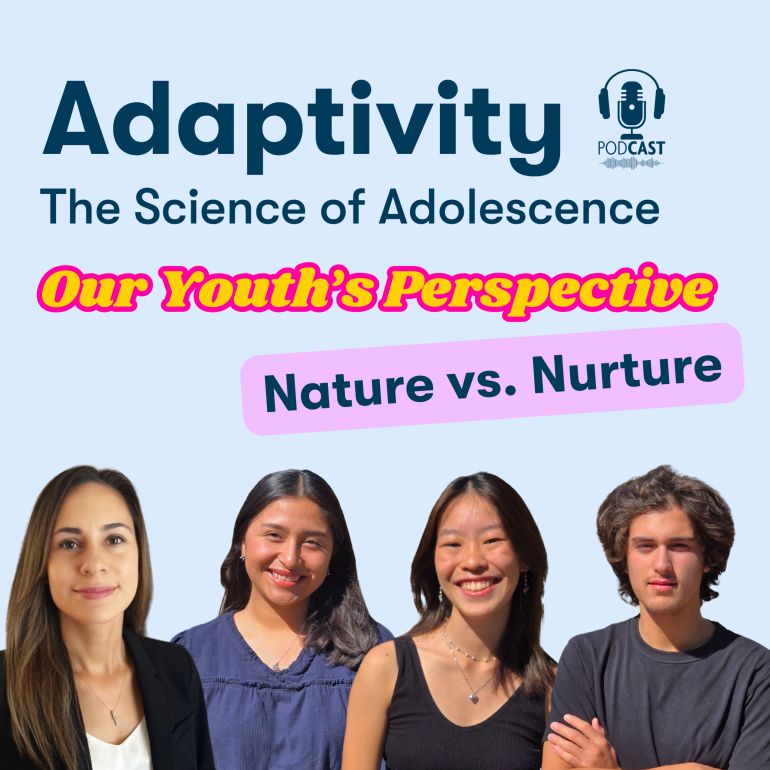
_350_350_80_c1.jpg)
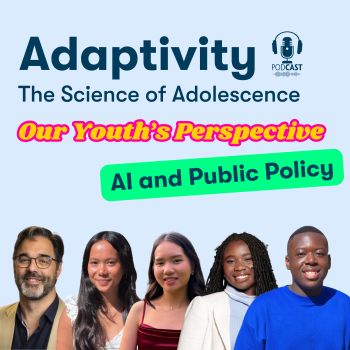
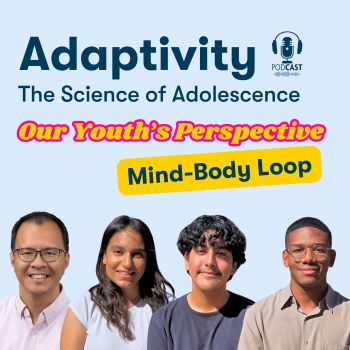
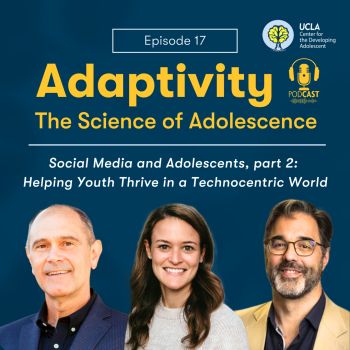

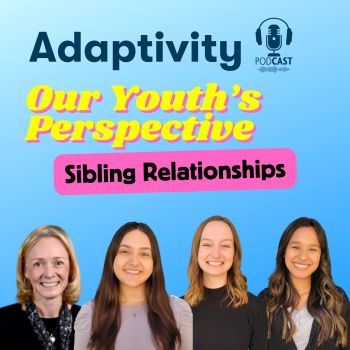
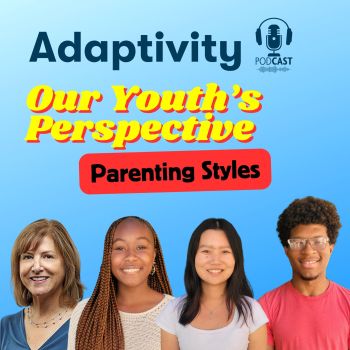

_350_350_80_c1.jpg)

